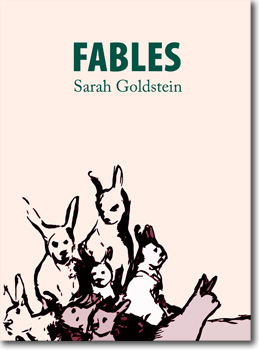
The Many Kinds of Sleep: “Fables” by Sarah Goldstein
Grim
I’ve been reading and re-reading Sarah Goldstein’s Fables before bed. I’m not one to do this: for me, my bed is for sleeping and sleeping only. I’ve never been a “read-before-I-go-to-sleep” person either as it’s too effective: the words start turning into absolute nonsense only a few minutes in and I will find myself reading the same page over and over again before I inevitably put the book down and forget everything that I just read. Yet this style of reading—under the covers with a pillow folded in half behind my back—seems appropriate for Fables, a gorgeous intertwining of allegorical stories presented in tiny fragments, dare I say breadcrumbs!, that display a horrifying yet beautiful world where mayors keep bones in boxes and ghosts enter through the beaks of birds.
Fables
In an interview with Avant-Women Writers, Kate Bernheimer, founder of Fairy Tale Review as well as the editor of a number of fairy tale anthologies discusses the importance of animals in fairy tales: “neither toad nor snake, bear nor hedgehog, is lower than a human on any scale of earthly significance.” There is a leveling in Goldstein’s stories as well: all things are equal—sons, daughters, mothers, fathers, birds, dogs. The fox conspires with the crows against the stag. The children, one day, decide to kill their father and burn him in the yard, yet they get in trouble for killing a toad and leaving it on their teacher’s chair. In dreaming there is leveling as well: all things are even, yet the fact that a fox can carry you in its mouth provides some sort of ordinary magic that is found in fairy tales, this matter-of-factness that permeates through the collection that makes you feel as if everything is all right even as the man with the melted face tells you to put olive oil in your ear to cure your sore throat. The world of Fables has this ordinary magic as well—at times I picture a forest with fireflies, other times I get images of rolling down car windows as students near the last few weeks of school before summer vacation. The language is reassuring, declarative: that we trust in whomever is telling us these fables, that the world that exists is a world that exists—that what happens here happens, that it will not disappear when someone wakes.
Ghosts
There is nothing romantic about the actual act of sleeping; sure, sleeping next to someone is interpreted as romance—to share a space that is considered private, to trust someone to the point that you are comfortable in being at your most vulnerable with them, that you are offering a slowed heart and soft breathing as a gift. Films make a huge deal about the act of “staying over”, something that seems to imply that the night was one thing, yet the beginning of the day is something else entirely. The moments before sleep and the moments after are the ones that stand a chance of meaning something—while it is impossible to remember the moment before you fall asleep, you remember the moments leading up to the moment: the checklist of things that need to be accomplished tomorrow, the assessment of what you did the day before, the random thoughts about loved ones, hated ones, lost ones, strange ones, and then nothing. There is little romance in these stories as well: not much room for love, yet there is something tender about it all. The ghost loves you while you are asleep, the farmer and his wife work only by moonlight. There is a longing in these words: a hope that things work out, that things return to the way that they once were, that things will continue to change as they always have. The ghosts don’t wish to be human, they simply wish.
Captives
There are times the collection has everything to do with watching: observing the people from across the river, looking down at one’s arms, rows of sacrifices left out for dead animals. These moments are quiet and powerful, coming from different sources: at one moment it could be the girls held captive by an unknown, another the voice of the one spinning the tale. In sleep, I see myself as if I were watching a film: the back of shoulders and overhead shots, like a ghost, perhaps. There’s something to simply watching, to taking notes for next time, yet being unable to affect anything: that all that is seen is all that has ever been known. In these stories we are placed in medias res, waking up somewhere new with no explanation as to why we are trudging through a swamp, why we are waiting in a field near a river. We are in, we observe, and then it ends, not in flying or a massive battle, but definitively—freed momentarily, yet still caught in what has happened.
The New World
is an ending. We fast forward to something unexpected like it were magic, and yet this is where the magic stops, with slick modernity and the recording of numbers into files. Whereas at the beginning things were being turned into other things, here we catalog what is left. The ghosts have all gone home, the children are at school, the foxes are resting. When you awaken, you won’t remember everything, but you’ll remember parts. At the end, it is all beautiful: a collage of images and voices that stick to your bones.
Brian Oliu is originally from New Jersey and currently lives in Tuscaloosa, Alabama. His work has been published in Hotel Amerika, New Ohio Review, Ninth Letter, Sonora Review, Puerto del Sol, and elsewhere. His collection of Tuscaloosa Craigslist Missed Connections, So You Know It’s Me is available through Tiny Hardcore Press.

[…] The Many Kinds of Sleep…by Brian Oliu, now at Specter Magazine (via spectermagazine) […]
[…] Brian Oliu reviews Sarah Goldstein’s Fables (Tarpaulin Sky Press, 2011) at Specter Magazine, and we are grateful. […]